Bow and Stern Thruster Facts, Part I: Improve Low-Speed Maneuverability
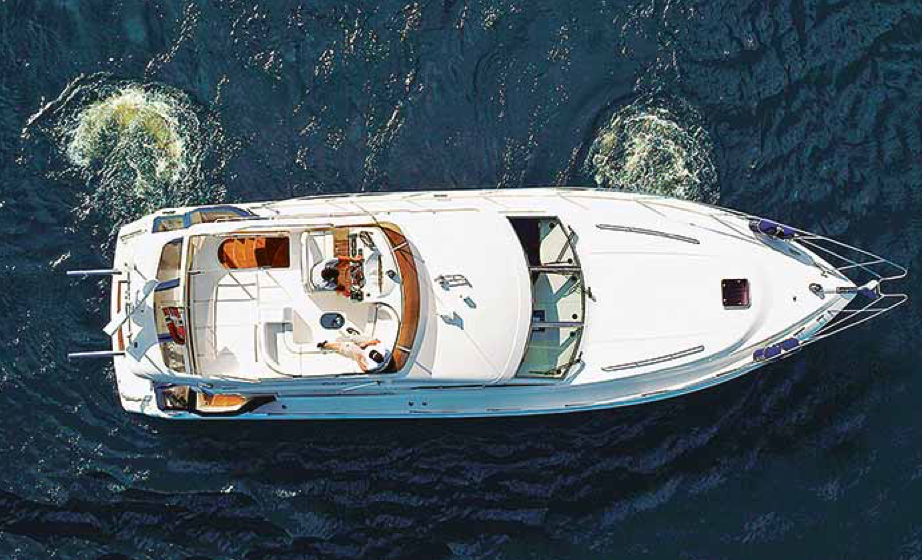
There’s no part of boating that’s more stressful than docking, particularly when we’re new at the helm or maneuvering an unfamiliar boat in a crowded harbor, perhaps with some wind and current thrown in for added spice. Single-screw boats and deep-keeled sailboats can be particularly challenging for all but the most experienced skippers.
Difficult Docking
Wind-catching boats — like today’s large pontoon boats of sportfishermen with flying bridges and lots of canvas — can be hard to control at low speeds. Bow and stern thrusters can also ease handling chores.
Thrusters can eliminate the common issue of the high bow being caught by the wind in stern-to docking — you control the stern with the engines and keep the bow straight with the thrusters. Crosscurrents can be equally challenging, for example, when going into a narrow slip in a river where the current is perpendicular to the dock. Equally as difficult is a tidal marina with a cross-current of several knots.

In certain places around the world, tidal currents can be extremely strong and the only way to get off a dock is with thrusters. Also, when going up current and you have to turn to port or starboard to thread your way into a narrow slip, with little maneuvering room, thrusters may be your only hope, unless you want to wait for slack tide.
Thrusters can take away much of the stress, even in tough circumstances or on boats you have not handled previously.
What are Thrusters?
Thrusters are added propulsion systems, most often installed at the bow, but sometimes at the stern. Most are DC powered, or hydraulically powered from PTOs on the transmission or a generator.
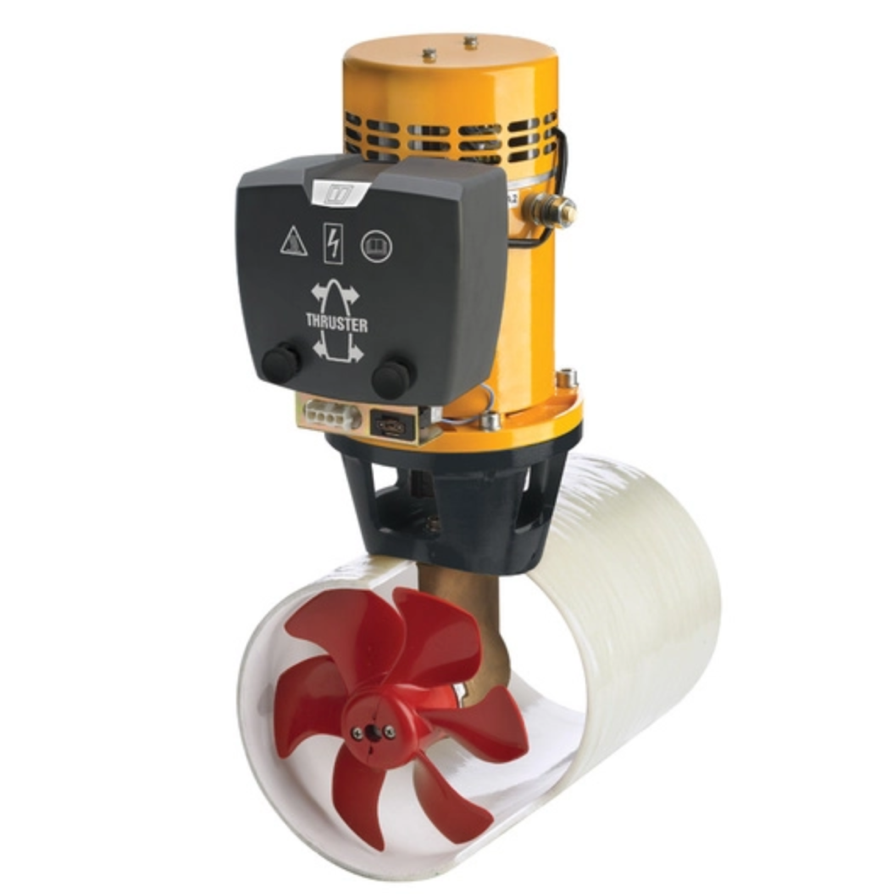
Which Boats Need Bow Thrusters?
The answer is no boats need them, but many can be enhanced with them. We must remember that boaters got by without bow thrusters for 70 years or so. The first ones started being used in the 1980s and they slowly caught on through the 1990s and early 2000s. Boat builders are notoriously conservative when it comes to new products that complicate the build.
Single-engine power and sailboats longer than 26’ (7.92 m) are good candidates for a bow thruster. Inexperienced operators taking the helm of larger twin-engine boats will welcome a bow thruster and perhaps a stern thruster as well. Also, captains who run almost any size of boat in challenging docking locations will find that thrusters make life much easier.
Virtually all cruising sailboats measuring more than 30’ (9.14 m) could make good use of a bow thruster because sailboat props are so small. Worse still are sailboats with folding props that are typically feeble in forward and problematical in reverse.
Affordable Alternatives
Boat owners who don’t want to pay for the high prices of joysticks can save money by opting for a thruster. Bow and stern thrusters accomplish at a moderate price what the expensive “joystick” digital shifting/steering systems now available on multiple-outboard or pod boats produce with the main engines. Further, they don’t cause wear and tear on the transmissions and lower units.
When buying a new boat, installing a bow thruster is one way to keep the cost of the vessel down.
Bow thrusters are usually mounted in a tunnel cut through the forefoot of the boat, or in a pocket near the bow that extends below the bottom when wanted. These can often move up to 90 degrees to the length of the boat when activated. In most models, the propeller can rotate clockwise as well as counterclockwise to push the bow to port or starboard.
Stern thrusters are typically mounted on the transom. There are even stern thrusters designed to fit on the lower units of an outboard or sterndrive and are steered with the boat’s helm; they provide low-speed impulses to push the stern to port or starboard and can be used in combination with a bow thruster to move the boat sideways or turn it in its own length.
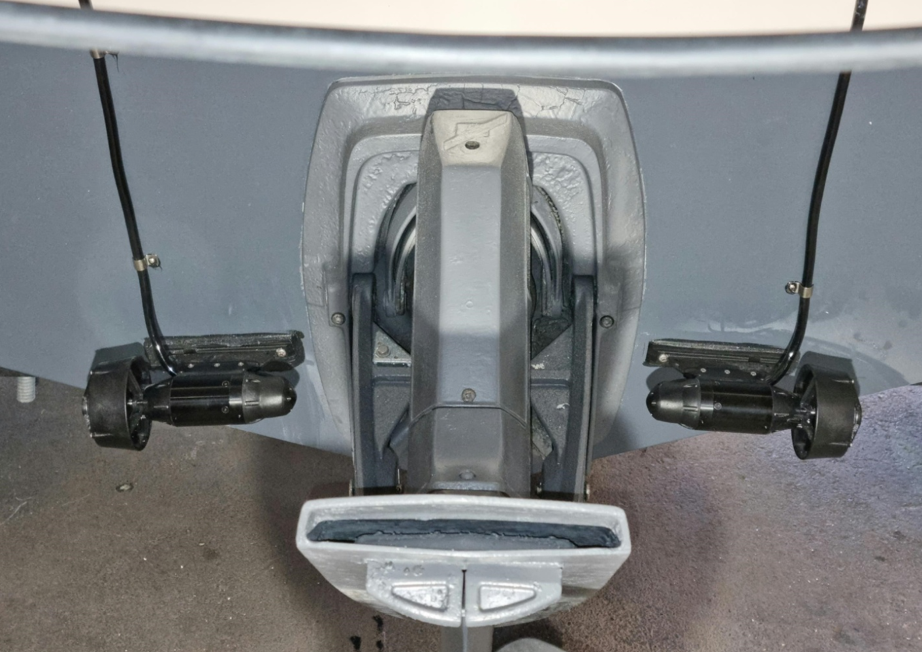
Constant and Variable Thrust
The majority of bow thrusters have on/off controls and deliver full power either to port or starboard when they are engaged. This is useful, but the operator has to be judicious in turning off the thruster quickly when enough impulse has been produced to push the bow to the desired position.
Proportional thrusters deliver varying degrees of power, letting the operator control the speed at which the thruster pushes the boat sideways. This allows more precise control of sideways movement.
Some proportional thrusters can be connected to joystick-operated helm controls, linking the main engine and propeller systems to the thrusters for improved low-speed maneuvering.
Tunnel Bow Thrusters
The most common bow thrusters have a tunnel installed through the bow of the boat below the waterline.
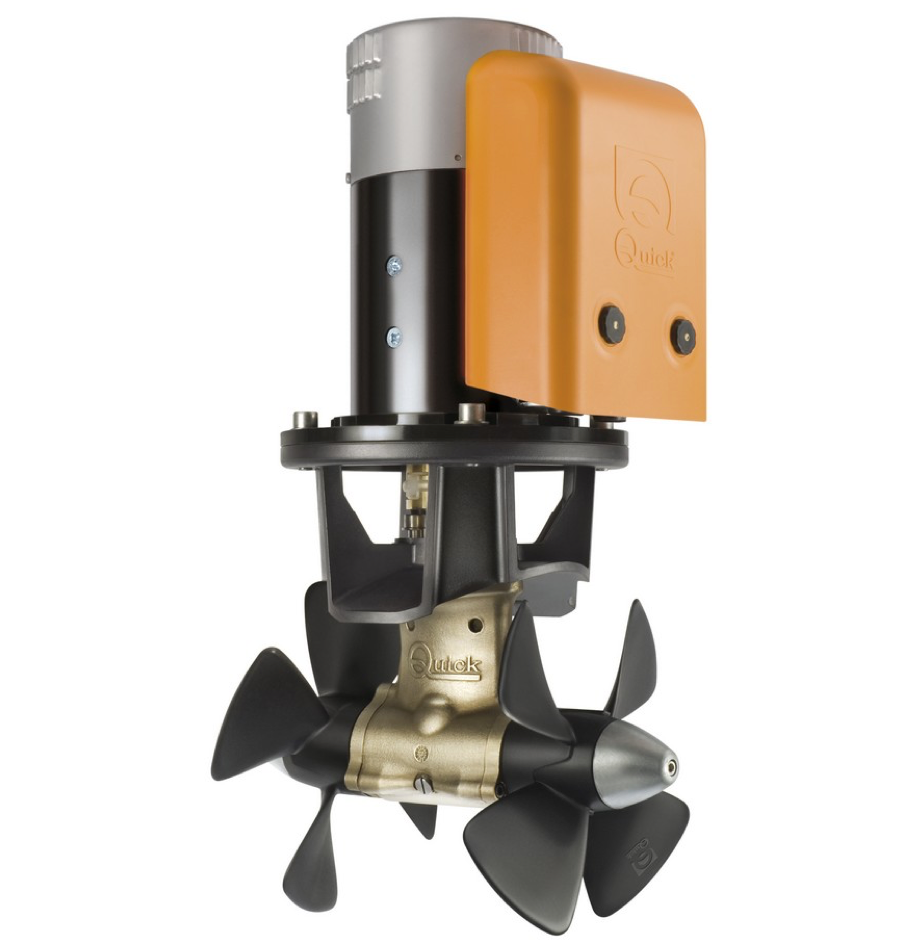
The tunnel is usually constructed of fiberglass or aluminum tubing, depending on the material of the hull. The tunnel protects the thruster blades and concentrates the thrust from the propeller.
One challenge with tunnels is creating a proper radius at each end of the tunnel to allow water to be sucked into the tunnel without cavitation (bubbles of air hitting the propeller blades). Usually, tunnel thrusters are out of the water at planing speeds.
In some high-performance powerboats, deflectors on the forward side of the tunnel entrances are used to minimize speed loss due to turbulence, though once the boat goes on plane, most tunnels are out of the water and have no effect on drag.
External thrusters are an option when a boat doesn’t have enough space for a tunnel to be installed, or when the cost would be prohibitive.
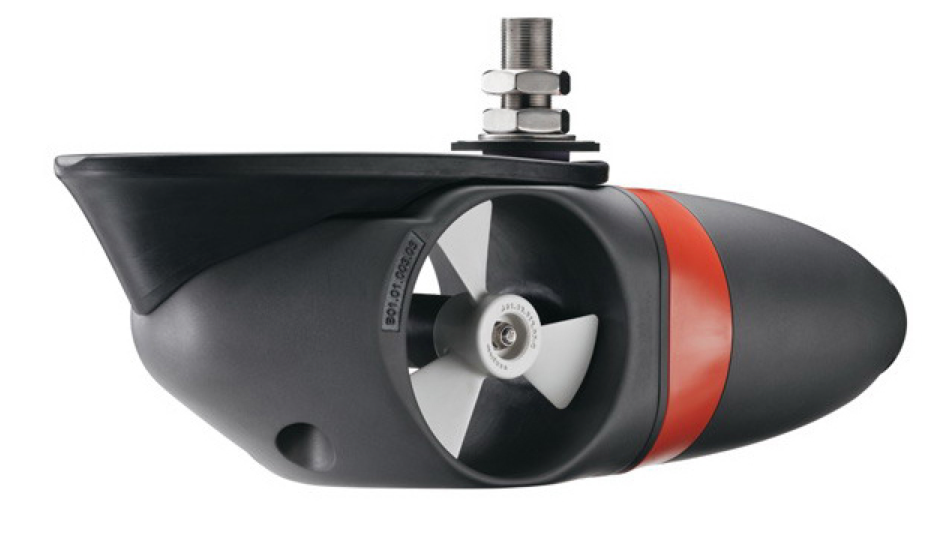
Some external bow thrusters are steerable — they are somewhat like an electric trolling motor used on flats and bay boats. While these thrusters are in the water at displacement speeds or at rest, they rise above the surface when the boat goes on plane to create minimal drag.
However, they can be damaged when beaching the bow or when putting the boat on a trailer that’s not fitted to accept the thruster.
Retractable Thrusters
Retractable thrusters greatly reduce the drag and turbulence caused by two holes in the forefoot of the boat. They are pulled up into the hull when not in use and deployed into the water with an actuator when needed.
For those with large performance boats, sail or power, who are worried about the smallest amounts of drag, a retractable thruster may be the best solution. Retractables work with all types of propulsion power — DC, AC and hydraulic. Because the gear leg is inside the boat, they usually need less maintenance. Also, since they’re not continuously exposed to saltwater there’s less need to replace the anodes.

Retractable thrusters also solve hull-space limitations due to draft. If the bow section of a boat is too shallow or swept upward, a tunnel thruster would be too close to the waterline to be effective.
More space is required inside the hull to install a retractable thruster, however. They also require professional installation — they’re generally better options only on larger boats that have plenty of interior volume forward.
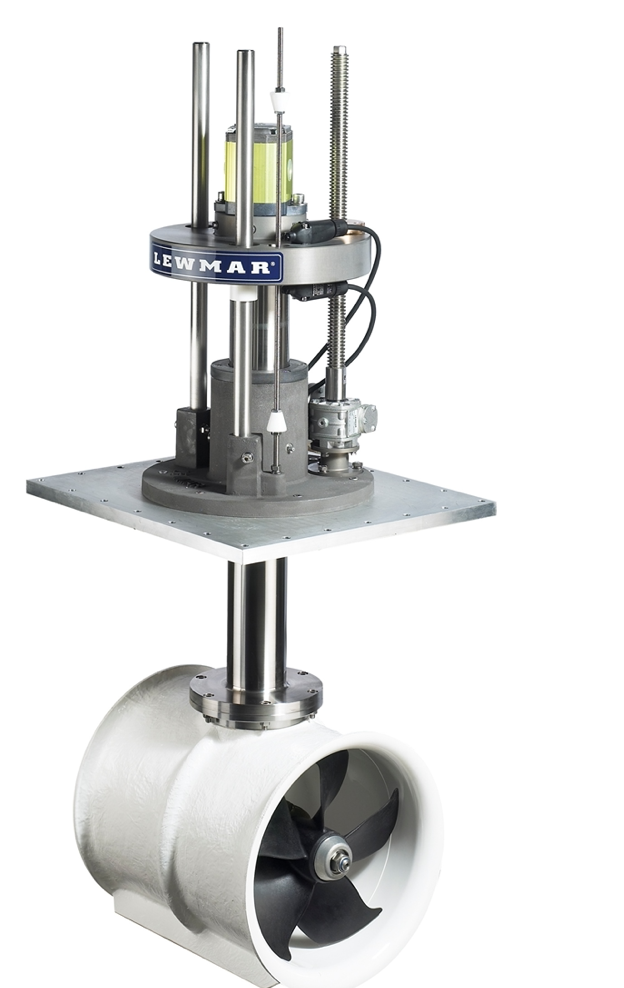
Propeller Choices
Thruster designs offer a variety of propeller choices.
Single propellers are the simplest, cost the least and are best for boats with shorter, smaller-diameter tunnels.
Tandem propellers are more efficient, making them a better choice when higher thrust is needed. However, they boost the price and require more space in the tunnel so they are only suitable on boats with adequate beam and volume forward.
Twin counter-rotating propellers provide the most efficiency, but cost considerably more. They also require more tunnel space. They’re found mostly on yachts 50’ (15.24 m) and larger.
We’ll take a look at power sources and other factors in selecting the best thruster for your boat in Part Two.
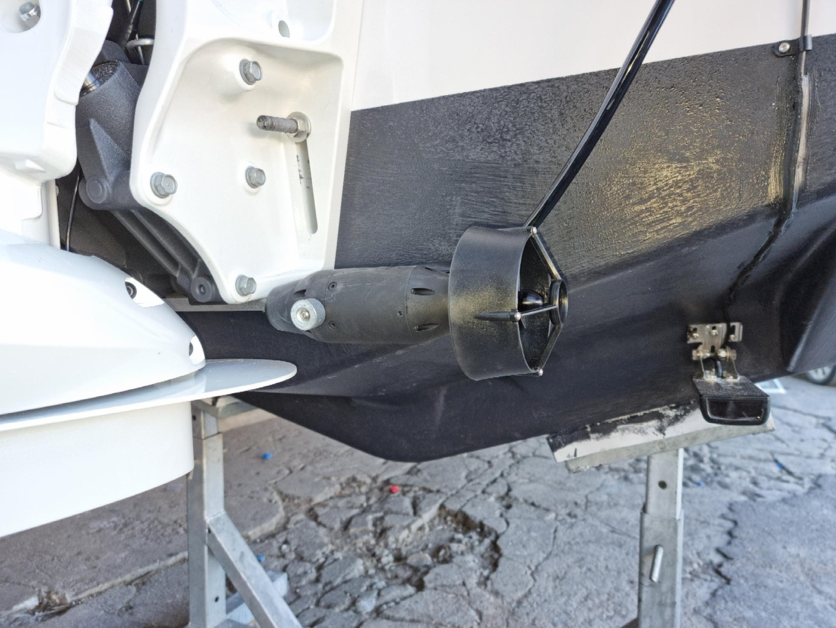
Electric or Hydraulic Thrusters?
In the early days of bow thrusters, they were notorious for quickly overheating and throwing the breaker, just when needed most. The solution was going to hydraulic thrusters with their pumps driven by power take-offs (PTO). Today, generally, the largest motoryachts, and particularly world cruisers are equipped with hydraulic thrusters with PTOs on the main engine transmissions or generators.
With hydraulics, large, thick, hoses to and from the thruster are installed. The result of the equipment needed makes them much more expensive than electric thrusters.
Over the last decade or so, electric thrusters have become much more reliable, and BoatTEST’s captains’ experience with them has been excellent. Also, word on the dock is that they are reliable now.
Nevertheless, the proper way to use electric or hydraulic thrusters is to bump them in and out of gear — and not lean on them. We have talked with owners that have told us that they have used electric thruster for up to three minutes continuously without overheating.
DIY Bow and Stern Thruster Installation
Most external-mount stern thrusters can be installed by the buyer in under a day, according to the manufacturers, so the overall cost can be reduced considerably.
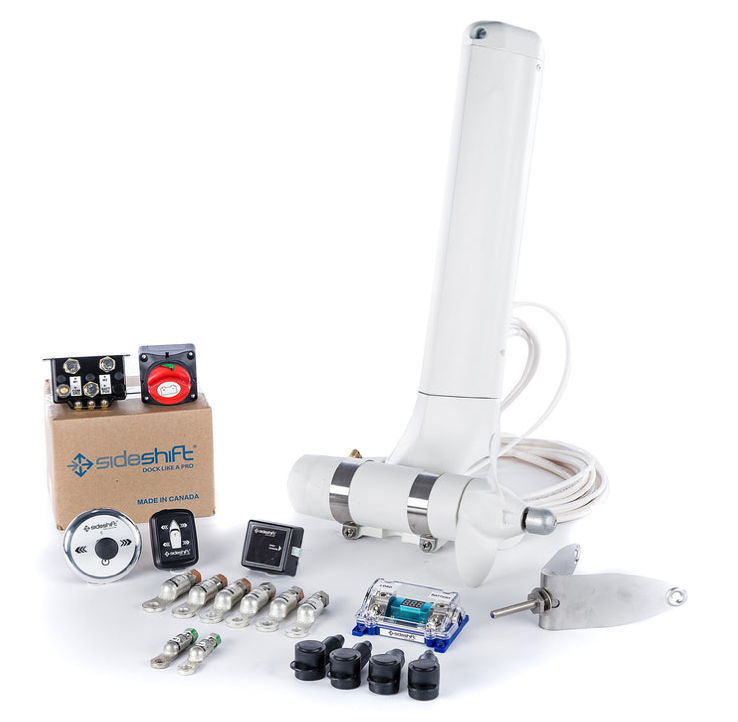
Companies like SideShift provide complete packages to make self-installation easy.
Whatever your operational needs or the size of your boat, it’s likely that a thruster or two can make your boating life easier, safer and more stress-free.
Thruster Manufacturers
- Anchorlift: http://anchorlifttechnic.com
- EZ Drive: www.ezdrivethruster.com
- Lewmar: www.lewmar.com
- Quick: www.quickusastore.com
- SideShift: www.sideshift.com
- Sleipner (formerly Side-Power): www.sleipnergroup.com
- Vetus: www.vetus.com
- Yacht Thruster: www.yachtthruster.com